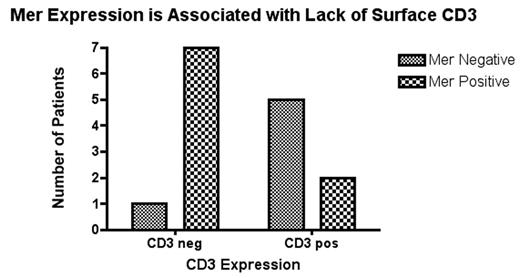Abstract
Tyrosine kinases play an important role in normal cellular growth and differentiation. Deregulation of tyrosine kinase activity can result in cellular transformation leading to the development of human cancer. The Mer receptor tyrosine kinase, initially cloned from a human B lymphoblastoid cell line, is expressed in a spectrum of hematopoetic, epithelial, and mesenchymal cell lines. Interestingly, while the RNA transcript of Mer is detected in numerous T and B lymphoblastic cell lines, Mer RNA is not found in normal human thymocytes, lymphocytes or in PMA/PHA stimulated lymphocytes. We have developed an anti-human Mer monoclonal antibody to further study the ectopic Mer expression in lymphoblasts. The antibody detects several forms of the Mer protein including a fully glycosylated 205 kD Mer protein in monocytes and a less glycosylated 170–180 kD Mer protein in acute lymphoblastic leukemia (ALL) cell lines. We analyzed lymphoblasts from 16 T cell ALL patients diagnosed between July 1995 and July 2004 at The Children’s Hospital, Denver for Mer protein surface expression. Of the T cell ALL patient samples, we found that 9/16 (56%) were positive for Mer protein surface expression. Although we were not able to statistically evaluate the clinical outcomes relative to Mer expression due to the study sample number, there was a statistically significant association between positive expression of Mer and lack of surface expression of CD3 (p = 0.035). We found that 7/9 (78%) of the Mer positive lymphoblasts lacked CD3 surface expression, while only 1/6 (17%) of the Mer negative samples lacked CD3 surface expression (see figure). Lymphoblasts that lack surface expression of CD3 represent an immature phenotype and have been associated with a decreased event free survival as compared with surface positive CD3 lymphoblasts. Further investigation of the ectopic expression of Mer in lymphoblasts may reveal the use of this novel Mer glycosylated protein as a prognostic marker and possibly a future therapeutic target in the treatment of childhood leukemia.
Author notes
Corresponding author


This feature is available to Subscribers Only
Sign In or Create an Account Close Modal